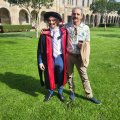A UQ study is using the social phenomenon “six degrees of separation” as a model to understand the inner working of human cells. The project aims to assist in the development of drugs with fewer side effects to combat many human diseases.
Using the emerging research field of complex systems to analyse information networks, Institute for Molecular Bioscience (IMB) scientist Dr Jennifer Hallinan is developing a complete picture of the biochemical interactions that occur in a cell.
Dr Hallinan said the “six degrees of separation” in human social interactions, occurred where there were believed to only be about six people between any two randomly selected individuals.
"The network of protein-protein interactions in a cell are very interconnected like the `six degrees of separation` and they both fit the model of small world networks," Dr Hallinan said.
"Another example of a small world network is the World Wide Web. It is estimated that while there are over eight billion pages of information on the Web, it takes only 11 mouse clicks on average to get from one `side` of the web to the other."
In a small world network there was a high degree of interconnectivity between nodes and they were arranged so that the average number of steps between individual nodes was vastly smaller than the size of the network.
Dr Hallinan said this phenomenon could also be applied to cells in the human body.
"Applied to a cell, this means that an important protein has many interactions with other proteins and biological molecules," she said.
"To check the side effects of a new drug, scientists could use small world network modelling to assess the number and range of interactions a molecule has, as well as the possible impacts caused by a drug altering the interactions of a particular protein."
Dr Hallinan was recently awarded the prestigious Steinmetz Fellowship at the Santa Fe Institute in the United States and departs for the US later this week to further her ground-breaking research in this leading edge field.
The IMB is one of Australia`s leading research institutes at the University of Queensland and links genomic discovery and bioinformatic facilities with state-of-the-art research in developmental biology, cell biology, structural biology and chemistry, so as to understand human and animal biology and to develop new pharmaceuticals, diagnostics, nanotechnologies and disease therapies.
The Santa Fe Institute (SFI) in the US, is one of the world`s premier “think-tank” institutes initiating new collaborative and multidisciplinary projects in previously uncharted scientific domains. The Steinmetz Fellowship supports a one-month research residency at the Santa Fe Institute providing the opportunity to pursue research projects in complex systems and to participate in SFI scientific activities.
Media: For further information please call Russell Griggs (07 3365 1805) or Helen Weatherley (0421 056 980).



